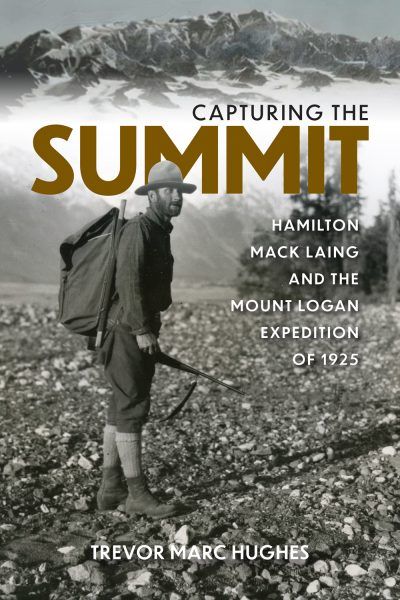
Capturing the Summit: Hamilton Mack Laing and the Mount Logan Expedition of 1925
Review By PearlAnn Reichwein and Lyndsay Conrad
September 12, 2023
BC Studies no. 218 Summer 2023 | p. 136-137
The story of the first ascent of Mount Logan has typically been told as a mountaineering epic wherein conquest overshadows science on the expedition to the Saint Elias Mountains in 1925. Naturalist Hamilton Mack Laing was barely visible while grizzled mountaineers conquered the king of peaks, yet Laing’s story is revealing and compelling. He was sent on the expedition by the Victoria Memorial Museum in Ottawa to collect wildlife specimens and film climbers on the journey to capture the Yukon massif. Trevor Marc Hughes tracks the connection of Laing’s story with natural history and photography amid changes in ornithology and conservation in early-twentieth-century Canada.
H.M. Laing grew up on a Manitoba farm where he learned about birds and guns, then embarked on an odyssey to Utah as a “motorcycle naturalist” that honed his abilities for travel and field studies. He joined federal fieldwork parties, leading to a career as a naturalist on expeditions in western Canada and abroad to Japan. In his forties, Laing was hired as the naturalist and cinematographer for the Mount Logan Expedition. Federal scientist Percy Taverner, author of Birds of Western Canada (1926), recommended Laing, whose specimens later contributed to the Ottawa museum collection that informed public reports and the writing of a foundational ornithology guide.
The book pursues a dual track with narratives following geologist Fred Lambart on the mountain and Hamilton Laing in the valley below. Hughes brings together action and the profane. Mountaineers play out weather, egos, and charades at elevation, while Laing pursues a steady pace of quiet work collecting specimens and data alone at timberline, listening closely to identify bird songs and observing wildlife behaviour as he immerses himself in the study of his surroundings at the foot of the Chitina moraine from May to August. He shoots and prepares Dall sheep, black bear, horned larks, wheatears, and yellow warblers to pack for transport to the Victoria Museum. The museum collector labours at drying bird skins, cleaning pelts, and boiling a coyote’s skull, along with his daily chores in camp, until he travels home, via Alaska, to Comox, British Columbia.
Readers, especially birders, will gain insights from this book that can also enrich classroom teaching. Well researched and based on trip diaries, reports, and museum catalogues, the book has a bibliography, index, and appendices. A valuable afterword sets Laing into a historical context pertinent to the traditions of natural history, with specimen collections and museums serving as scientific and educational means of advancing conservation and ecological thinking. Collections, like first ascents, were a form of conquest. Hughes grapples with how specimens and photography served conservation. Consequently, the role of Canada’s federal scientists and surveyors in shaping knowledge emerges in the narrative as it traces the work of Laing for the Victoria Museum and Lambert for Geodetic Surveys.
The Migratory Birds Convention, signed in 1916, is a policy backdrop for Laing’s museum collecting and his work with Ottawa colleagues, including Taverner who was instrumental in negotiations for international bird protection. Overall, the book highlights the significance of state-backed science and conservation in Canada and the United States, a public good that continues today strengthened by Indigenous Traditional Ecological Knowledge and citizen science. Affirming international cooperation, not only in the climbing world of the Saint Elias Mountains, but also for the protection of migratory species, this book concludes that Laing and Taverner presented ecology as seen through the lives of birds. In the face of extinction pressures, they hoped for sportsmen’s ethics, camera hunting, and the recovery of bird populations. Laing’s work illustrates survival concerns for birds and habitat, and echoes with migratory bird conservation, scientific observation, and fascination a century later.
Publication Information
Hughes, Trevor Marc. Capturing the Summit: Hamilton Mack Laing and the Mount Logan Expedition of 1925. Vancouver: Ronsdale Press, 2023. 240 pp. $24.95 paper.
